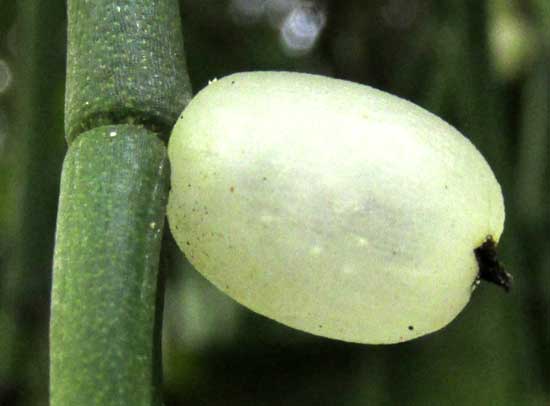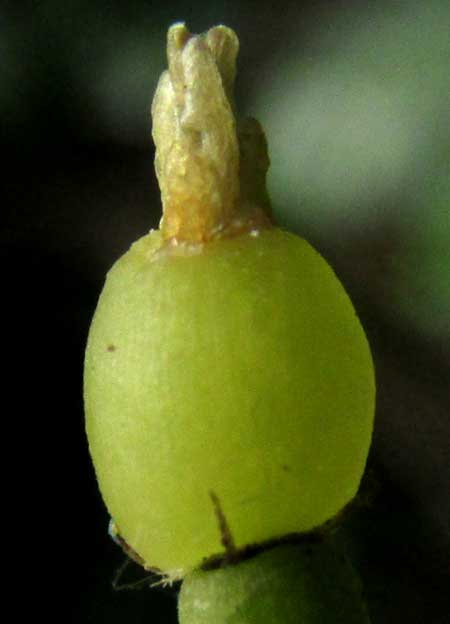Excerpts from Jim Conrad's
Naturalist Newsletter
from the December 7, 2018 Newsletter with notes from a camping trip to Chiapas, the southernmost state of MÉXICO
MISTLETOE CACTUS FRUITING
Last October 4th during my camping trip to Chiapas, in Maya Bell Campground near the ruins of Palenque, the trunk of a large tree was fairly covered with vine stems, creeping aroids, orchids, bromeliads and, in one place, a dangling, un-cactusy-looking cactus, shown below:

Normally I need both flowers and spines to identify a cactus, but this species bore neither. Still, its general appearance was so unique that the species is famous among cactus connoisseurs, and many know it by sight. One English name for the species is Mistletoe Cactus. It's RHIPSALIS BACCIFERA, native to Mexico, and as a handsome novelty often grown as an ornamental elsewhere.
In the above picture, notice that many of the cactus's dangling stems are tipped with something pea-sized and white. Those are fruits, a ripe one emerging at a stem node is seen below:

Technically, the small fruit is a berry, meaning that it's fleshy with more than one seed. Traditionally such fruits have been collected for eating. I find them a little tasteless, but they make nice nibbling while walking around. In the Cactus Family, the Cactaceae, flower ovaries are inferior, meaning that the calyx, corolla and sexual parts arise above the ovary instead of at its base. That explains the blackish item at the fruit's far end, which is the dried, shriveled-up calyx. I looked for flowers, but they were all gone. However, one immature ovary still bore the semi-dried-out remains of a flower, shown below:

Something interesting about that picture is that mature Mistletoe Cacti are described as usually spineless, but at the base of the above ovary you can make out some minute barbs, maybe even a branched one.
Something else interesting about this species is its distribution. The entire Cactus Family is almost exclusively native to the Americas. Pricklypear infestations in the Mediterranean area, Australia and elsewhere are weedy invasives from the New World. The "almost" in the above "almost exclusively native" is due to the Mistletoe Cactus. It's the only cactus species naturally occurring in the Old World. Its entire native distribution area ranges from Florida and the Caribbean south through Mexico and Central America into most of South America, as well as southern Africa, Madagascar and Sri Lanka.
It's an unsolved mystery how the Mistletoe Cactus accomplished this. The two main theories are: Somehow the plants got across the Atlantic, as by seeds carried by birds in their guts, and; The species separated into two populations when Continental Drift parted the Americas from Africa. It's also possible that during the 1500s sailors carried the cacti or seeds across the Atlantic, then birds quickly disseminated the species over a large area so that it just seemed to the earliest botanical explorers that it was native to Africa and Asia.